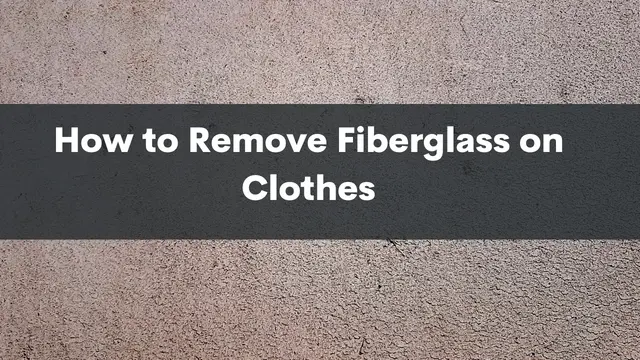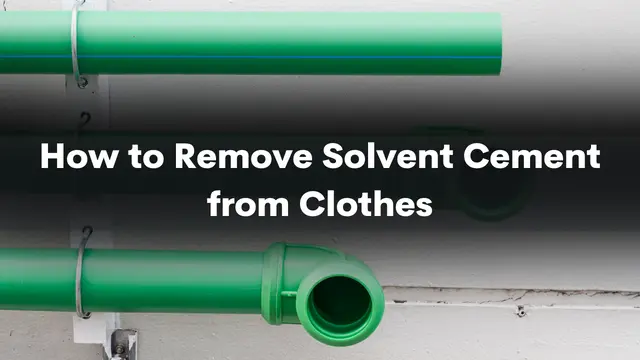Have you ever found yourself in a situation where you accidentally brushed against a fiberglass surface, only to discover later that your clothes were covered in those pesky fibers?
Fiberglass can be quite stubborn and cling to fabrics, making it challenging to remove.
In this comprehensive guide, we will walk you through the step-by-step process of removing fiberglass from clothes, ensuring that your favorite garments are restored to their former glory.
Contents
Understanding Fiberglass: More Than Just an Irritating Substance
Before delving into the methods of removing fiberglass from clothes, it’s essential to understand what fiberglass is and its common uses.
Fiberglass is a material made from fine fibers of glass that are woven together, resulting in a strong and lightweight product.
It has a wide range of applications, from insulation in buildings and automobiles to reinforcement in various composite materials.
However, despite its utility, fiberglass can pose risks when it comes into contact with the skin or gets embedded in clothing.
The sharp microscopic fibers can cause irritation, itching, and even allergic reactions. Therefore, it’s crucial to address the issue promptly and take necessary precautions to avoid any potential health hazards.
Precautions and Protective Measures: Shielding Yourself from Fiberglass Mishaps
As the saying goes, prevention is better than cure. By taking a few precautions and implementing protective measures, you can significantly reduce the chances of fiberglass getting on your clothes. Here are some essential steps to keep in mind:
- Cover up: When working in fiberglass-prone areas, such as construction sites or workshops, wear appropriate clothing that covers your skin as much as possible. Long-sleeved shirts, long pants, and closed-toe shoes are your best bet.
- Wear protective gear: Along with clothing, consider wearing additional protective gear like gloves, goggles, and a face mask. These items act as an extra barrier against fiberglass fibers, preventing them from directly contacting your skin or clothing.
- Minimize contact: Avoid unnecessary contact with fiberglass whenever possible. Be cautious when handling fiberglass-based products, and if you suspect any surface might have loose fibers, take extra care to avoid brushing against it.
By following these precautions, you can significantly reduce the likelihood of fiberglass finding its way onto your clothes. However, accidents can still happen, so it’s important to know what steps to take if you find yourself in such a situation.
Removing Fiberglass from Clothes: Step-by-Step Guide
Accidentally getting fiberglass on your clothes can be frustrating, but don’t panic! With the right approach and a little patience, you can successfully remove those stubborn fibers.
Follow this step-by-step guide to ensure that your clothes are fiberglass-free once again.
Step 1: Immediate Actions
As soon as you realize that fiberglass has come into contact with your clothing, it’s important to take immediate action.
This will help prevent the fibers from embedding further and minimize the risk of skin irritation. Here’s what you should do:
- Move to a well-ventilated area: Fiberglass particles can become airborne, leading to inhalation or further contamination. Step away from the source of fiberglass and go to a well-ventilated space.
- Handle the clothing with care: Avoid vigorously shaking or brushing the clothing, as this can release more fibers and make the situation worse. Instead, handle the affected garment gently to prevent further spreading.
Step 2: Gentle Shaking and Brushing
Begin by gently shaking the clothing outdoors to dislodge any loose fiberglass fibers. Be careful not to shake it too vigorously, as this can cause the fibers to spread further. After shaking, use a soft-bristle brush or a lint roller to remove any remaining loose fibers. Remember to brush in one direction to avoid pushing the fibers deeper into the fabric.
Step 3: Sticky Tape or Lint Roller Technique
To further eliminate fiberglass particles, employ the sticky tape or lint roller technique.
Simply wrap a piece of sticky tape, such as duct tape or packing tape, around your hand with the sticky side facing outwards.
Pat the affected areas of the clothing with the tape, pressing gently to lift any remaining fibers. Repeat this process until you no longer notice any fiberglass adhering to the tape.
Alternatively, you can use a lint roller designed specifically for removing debris from clothing. Roll it over the affected areas, applying light pressure to pick up the remaining fibers.
Step 4: Washing and Rinsing Techniques
After completing the initial fiber removal steps, it’s time to launder the clothing. Follow these washing and rinsing techniques to further eliminate any residual fiberglass:
- Isolate the garment: Wash the affected clothing separately from other items to prevent cross-contamination.
- Choose the right detergent: Use a mild detergent that is suitable for your fabric type. Avoid using bleach or fabric softeners, as these can potentially worsen the situation.
- Select a gentle wash cycle: Opt for a delicate or gentle wash cycle to minimize agitation. High-speed spinning may cause the fiberglass fibers to embed deeper into the fabric.
- Rinse thoroughly: After the wash cycle is complete, rinse the garment thoroughly to ensure all detergent and remaining fibers are removed.
Step 5: Drying and Inspection
Once you’ve completed the washing process, it’s time to dry the clothing. However, be cautious when handling damp clothes, as fiberglass fibers can become more mobile in a wet environment. Follow these steps for safe drying:
- Air drying: Whenever possible, air dry the clothing instead of using a dryer. Hang it outdoors or in a well-ventilated area to allow the fibers to disperse naturally.
- Inspect the clothing: After the garment is fully dry, inspect it under good lighting to ensure that no fiberglass fibers remain. If you spot any remaining fibers, repeat the previous steps or consider professional cleaning.
By following these step-by-step instructions, you can effectively remove fiberglass from your clothes. However, in certain cases or with delicate fabrics, additional care may be required.
Special Cases and Troubleshooting: Dealing with Embedded Fiberglass
While the previous steps are effective for most cases, there are situations where fiberglass fibers may become embedded in delicate fabrics or fabrics that cannot be easily washed.
In these special cases, alternative methods can be employed to remove the embedded fibers and ensure the safety of your clothing. Let’s explore these scenarios and troubleshooting tips:
Dealing with Embedded Fiberglass in Delicate Fabrics
If you find fiberglass fibers embedded in delicate fabrics such as silk, lace, or cashmere, it’s crucial to exercise extra caution.
Harsh brushing or washing methods can damage these fabrics, so it’s important to follow these specialized steps:
- Isolate the garment: Separate the affected garment from other items to prevent any further contamination.
- Gently shake and pat: Begin by gently shaking the garment to dislodge any loose fibers. Then, use a soft brush or a lint-free cloth to gently pat the fabric, encouraging the fibers to release.
- Use sticky tape or a vacuum: Employ the sticky tape technique described earlier to lift any remaining fibers from the fabric. Alternatively, you can use a handheld vacuum cleaner with a soft brush attachment to suction the fibers away.
- Consult a professional cleaner: If the embedded fibers persist or if you are unsure about handling delicate fabrics yourself, it’s advisable to seek the assistance of a professional cleaner. They have the expertise and tools to effectively remove the fiberglass while minimizing damage to the fabric.
Removing Fiberglass from Clothes That Cannot Be Washed
In some cases, certain clothing items cannot be washed due to fabric composition, embellishments, or other reasons. Here’s how you can still remove fiberglass from such clothes:
- Isolate the garment: Keep the affected clothing item separate from other garments to prevent spreading fibers.
- Gently shake and pat: As mentioned earlier, gently shake the clothing to dislodge loose fibers. Then, use a soft brush or lint-free cloth to pat the fabric and remove any visible fibers.
- Use sticky tape or a lint roller: Employ the sticky tape or lint roller technique to further lift any remaining fibers from the fabric’s surface.
- Spot cleaning: If the clothing has a small stained area with embedded fibers, you can try spot cleaning with a mild detergent and a soft cloth. Dampen the cloth with the detergent solution and gently dab the stained area. Rinse the cloth thoroughly and dab the area again to remove any residue.
- Air out and inspect: Hang the clothing in a well-ventilated area to allow any remaining fibers to disperse. Inspect the fabric under good lighting to ensure all visible fibers are removed before wearing the garment again.
Handling Allergic Reactions or Skin Irritation
If you experience allergic reactions or skin irritation due to fiberglass exposure, it’s important to address these symptoms promptly. Here are some measures you can take:
- Cleanse the affected area: Wash the affected skin gently with mild soap and lukewarm water to remove any fiberglass particles that may be causing irritation.
- Apply a soothing agent: Use a hypoallergenic lotion or aloe vera gel to calm the irritated skin. Avoid applying any products that may further irritate the skin, such as perfumed lotions or creams.
- Seek medical advice: If the symptoms persist or worsen, it’s advisable to consult a healthcare professional. They can provide appropriate medical advice and recommend any necessary treatments to alleviate the allergic reactions or skin irritation.
Remember, when dealing with embedded fiberglass or fabrics that cannot be washed, always prioritize your safety and seek professional help if needed.
Additional Tips and Recommendations: Preventing Fiberglass Mishaps
Now that you’re equipped with the knowledge of removing fiberglass from clothes, it’s time to focus on prevention.
Here are some additional tips and recommendations to keep in mind:
1. Wear Protective Clothing
When working in environments where fiberglass exposure is likely, always wear appropriate protective clothing. Consider the following:
- Coveralls or disposable suits: These provide full-body protection and prevent fiberglass from coming into direct contact with your clothes.
- Gloves: Choose gloves made from materials like nitrile or rubber to create a barrier between your skin and fiberglass.
- Eye protection: Safety goggles or glasses shield your eyes from airborne fiberglass particles.
- Respiratory protection: In situations where fiberglass dust or particles are prevalent, wear a properly fitted mask or respirator to prevent inhalation.
Investing in and using proper protective clothing can minimize the risk of fiberglass getting onto your clothes or skin.
2. Create a Barrier
Creating a barrier between yourself and fiberglass can help prevent contamination. Consider these preventive measures:
- Use plastic or polyethylene sheets: Cover surfaces with plastic or polyethylene sheets before working with fiberglass. This reduces the chances of loose fibers spreading and clinging to nearby objects, including your clothing.
- Tape off openings: Seal off any openings or gaps in the workspace to prevent fiberglass particles from entering the area and settling on your clothes.
These barriers act as a first line of defense against fiberglass contamination, protecting your clothing in the process.
3. Clean and Maintain Workspaces
Maintaining a clean and organized workspace is essential for preventing fiberglass mishaps. Follow these guidelines:
- Regular cleaning: Regularly clean work surfaces and tools to remove any accumulated fiberglass dust or loose fibers. Use a damp cloth or a vacuum with a HEPA filter for effective cleaning.
- Proper waste disposal: Dispose of fiberglass waste in sealed plastic bags or containers to prevent the fibers from becoming airborne and contaminating your clothes or the environment.
- Wash hands and exposed skin: After working with fiberglass, thoroughly wash your hands and any exposed skin to remove any loose fibers.
Incorporating these cleaning practices into your routine can minimize the chances of fiberglass transferring onto your clothes.
4. Educate Others
Share your knowledge and experiences with others to raise awareness about the risks associated with fiberglass exposure.
By educating your peers and colleagues, you can collectively work towards creating a safer working environment.
Encourage them to follow best practices, such as wearing protective clothing and implementing preventive measures.
5. Professional Assistance
In situations where the removal of fiberglass from clothes becomes challenging or if you have concerns about potential health risks, it’s always wise to seek professional assistance.
Professional cleaners have the expertise and specialized techniques to handle fiberglass-contaminated garments effectively.
Remember, prevention is key when it comes to fiberglass mishaps. By adopting these preventive measures and sharing your knowledge, you can help create a safer environment for everyone.
Frequently Asked Questions (FAQs)
Here are some frequently asked questions about removing fiberglass from clothes:
1. Can fiberglass permanently damage my clothes?
While fiberglass fibers can be stubborn, they usually do not cause permanent damage to clothing. With proper removal techniques, you can effectively eliminate the fibers and restore your clothes to their previous condition.
2. What should I do if I accidentally inhale fiberglass particles?
If you accidentally inhale fiberglass particles and experience respiratory discomfort or irritation, it’s advisable to seek fresh air and move to a well-ventilated area. If symptoms persist or worsen, consult a healthcare professional for further guidance.
3. Can I use a vacuum cleaner to remove fiberglass from clothing?
Using a vacuum cleaner with a HEPA filter can be an effective method for removing loose fiberglass particles from clothing. Ensure that the vacuum’s suction power is not too strong, as it may damage delicate fabrics.
4. Is it safe to wash fiberglass-contaminated clothes with other laundry items?
To prevent cross-contamination, it is recommended to wash fiberglass-contaminated clothes separately from other laundry items. This reduces the risk of transferring fibers to other garments.
5. Can I remove embedded fiberglass from clothing by freezing it?
Freezing clothing to remove embedded fiberglass is not recommended, as it may not effectively dislodge the fibers. It’s best to follow the recommended removal techniques outlined in this guide.
6. What should I do if I have a severe allergic reaction to fiberglass?
If you experience a severe allergic reaction to fiberglass, such as difficulty breathing, swelling, or severe skin irritation, seek immediate medical attention. Contact a healthcare professional or call emergency services for prompt assistance.
Remember, if you have any specific concerns or encounter difficulties while removing fiberglass from clothes, it’s always best to consult a professional or seek appropriate advice.
In Closing..
Dealing with fiberglass on clothes can be a frustrating experience, but armed with the knowledge from this guide, you are now equipped to tackle the issue confidently.
Whether it’s through immediate actions, gentle removal techniques, or specialized approaches for delicate fabrics, you can effectively remove fiberglass fibers from your clothes.
Remember to prioritize safety, take preventive measures, and share your newfound knowledge with others.
By incorporating these tips and recommendations, you can significantly reduce the chances of encountering fiberglass mishaps in the future.
Keep your clothes fiberglass-free and enjoy peace of mind knowing that you are well-prepared to handle any fiberglass-related challenges that come your way.



